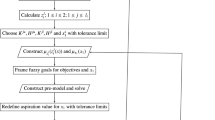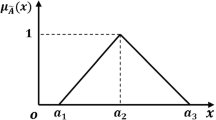Abstract
This paper proposes a method to solve a bi-level linear fuzzy fractional programming problem comprising all its constants and coefficients expressed in form of trapezoidal fuzzy numbers. Fuzzy \(\alpha , \beta \)-cuts are respectively used in the objective functions and constraints to equivalently transform the bi-level fuzzy optimization into bi-level interval valued form. Subsequently, a bi-level bi-objective linear fractional programming problem is generated. Change of variable method is implemented to construct linear fuzzy membership functions at upper and lower level. Fuzzy goal programming eliminating over deviations from aspiration level of fuzzy membership functions along with a proposed modified linearization process of fractional functions are together used to determine the compromise solution of the problem. To illustrate and justify the feasibility of the proposed method, an existing numerical problem is solved and the results obtained are comparatively analyzed.
Access this chapter
Tax calculation will be finalised at checkout
Purchases are for personal use only
Similar content being viewed by others
References
Abo-Sinna MA (2001) A bi-level non-linear multi-objective decision making under fuzziness. Opsearch 38(5):484–495
Arora SR, Gupta R (2009) Interactive fuzzy goal programming approach for bilevel programming problem. Eur J Oper Res 194(2):368–376
Arya R, Singh P, Kumari S, Obaidat MS (2020) An approach for solving fully fuzzy multi-objective linear fractional optimization problems. Soft Computing 24(12):9105–9119
Borza M, Rambely AS (2022) An approach based on \( alpha \)-cuts and max-min technique to linear fractional programming with fuzzy coefficients. Iran J Fuzzy Syst 19(1):153–168
Calvete HI, Galé C (1999) The bilevel linear/linear fractional programming problem. Eur J Oper Res 114(1):188–197
Chakraborty M, Gupta S (2002) Fuzzy mathematical programming for multi objective linear fractional programming problem. Fuzzy Sets Syst 125(3):335–342
Charnes A, Cooper WW (1962) Programming with linear fractional functionals. Naval Res Logistics Q 9(3–4):181–186
Toksari MD (2010) Taylor series approach for bi-level linear fractional programming problem. Selçuk J Appl Math 11(1):63–69
Hirche J, Craven BD (1989) Fractional programming. Berlin, Heldermann Verlag 1988, 145 p, DM 48. ISBN 3-88538-404-3 (Sigma Series in Applied Mathematics 4). Zeitschrift Angewandte Mathematik und Mechanik, 69(10), 371–371 (1989)
Malhotra N, Arora SR (2000) An algorithm to solve linear fractional bilevel programming problem via goal programming. Opsearch 37(1):1–13
Mehra A, Chandra S, Bector CR (2011) Acceptable optimality in linear fractional programming with fuzzy coefficients. Fuzzy Optim Decis Making 6(1):5–16
Miettinen K (2012) Nonlinear multiobjective optimization (Vol 12). Springer Science & Business Media
Mishra S (2007) Weighting method for bi-level linear fractional programming problems. Eur J Oper Res 183(1):296–302
Pal BB, Moitra BN, Maulik U (2003) A goal programming procedure for fuzzy multiobjective linear fractional programming problem. Fuzzy Sets Syst 139(2):395–405
Pramanik S, Dey PP (2011) Bi-level linear fractional programming problem based on fuzzy goal programming approach. Int J Comput Appl 25(11):34–40
Saad OM, Hafez MS (2011) An algorithm for solving bi-level integer linear fractional programming problem based on fuzzy approach. General Math Notes 3:86–99
Stancu-Minasian IM (2012) Fractional programming: theory, methods and applications (Vol 409). Springer Science & Business Media
Stanojević B, Dzitac S, Dzitac I (2020) Fuzzy numbers and fractional programming in making decisions. Int J Inf Technol Decis Making 19(04):1123–1147
Thirwani D, Arora SR (1993) Bi-level linear fractional programming problem. Cahiers du Centre d’études de recherche opérationnelle 35(1–2):135–149
Veeramani C, Sumathi M (2016) A new method for solving fuzzy linear fractional programming problems. J Intell Fuzzy Syst 31(3):1831–1843
Zimmermann HJ (2011) Fuzzy set theory and its applications. Springer Science & Business Media
Author information
Authors and Affiliations
Corresponding author
Editor information
Editors and Affiliations
Rights and permissions
Copyright information
© 2023 The Author(s), under exclusive license to Springer Nature Singapore Pte Ltd.
About this paper
Cite this paper
Maharana, S., Nayak, S. (2023). Bi-Level Linear Fuzzy Fractional Programming Problem Under Trapezoidal Fuzzy Environment: A Solution Approach. In: Uddin, M.S., Bansal, J.C. (eds) Proceedings of International Joint Conference on Advances in Computational Intelligence. IJCACI 2022. Algorithms for Intelligent Systems. Springer, Singapore. https://doi.org/10.1007/978-981-99-1435-7_38
Download citation
DOI: https://doi.org/10.1007/978-981-99-1435-7_38
Published:
Publisher Name: Springer, Singapore
Print ISBN: 978-981-99-1434-0
Online ISBN: 978-981-99-1435-7
eBook Packages: Intelligent Technologies and RoboticsIntelligent Technologies and Robotics (R0)




